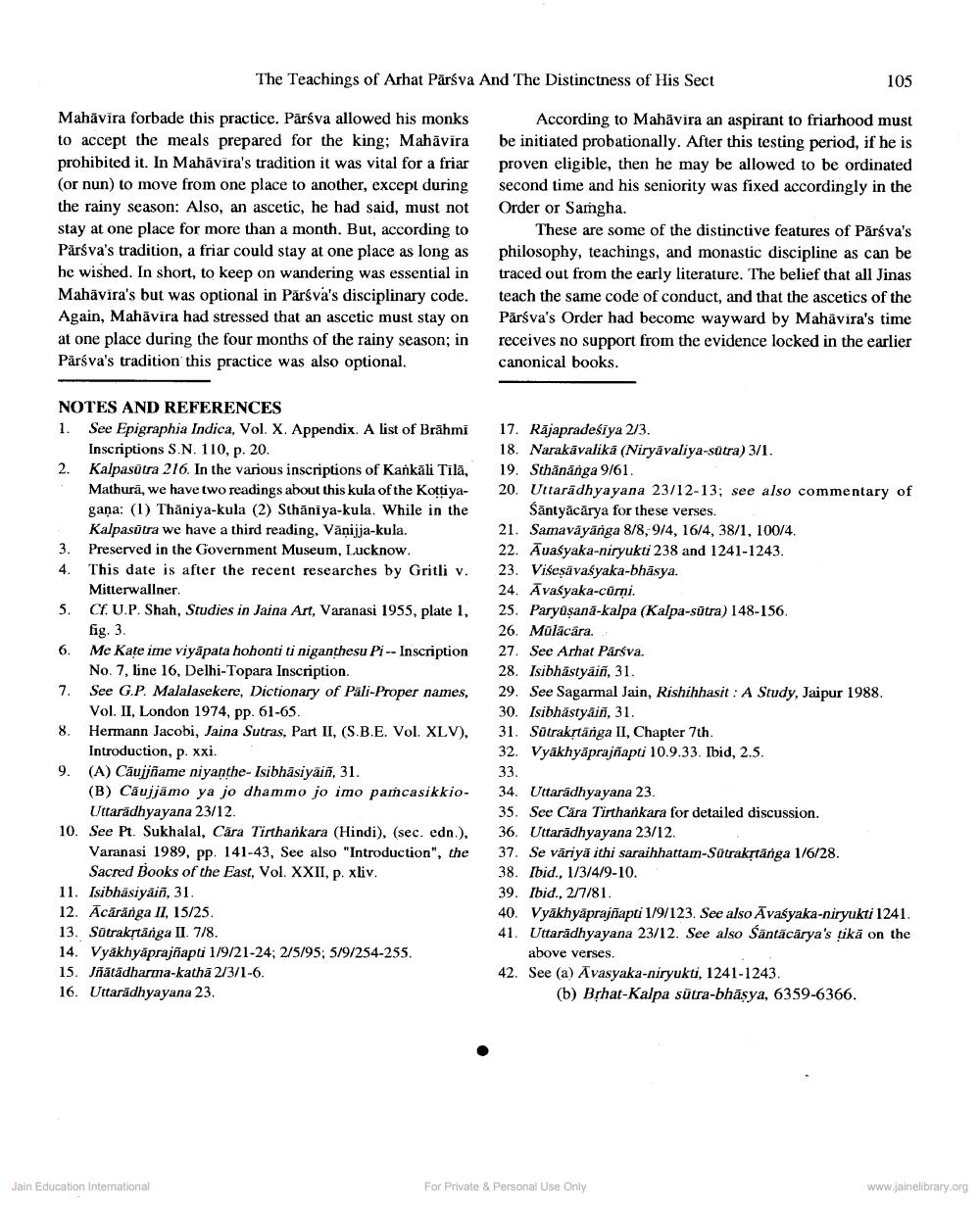________________ The Teachings of Arhat Parsva And The Distinctness of His Sect 105 Mahavira forbade this practice. Parsva allowed his monks to accept the meals prepared for the king; Mahavira prohibited it. In Mahavira's tradition it was vital for a friar (or nun) to move from one place to another, except during the rainy season: Also, an ascetic, he had said, must not stay at one place for more than a month. But, according to Parsva's tradition, a friar could stay at one place as long as he wished. In short, to keep on wandering was essential in Mahavira's but was optional in Parsva's disciplinary code. Again, Mahavira had stressed that an ascetic must stay on at one place during the four months of the rainy season; in Parsva's tradition this practice was also optional. According to Mahavira an aspirant to friarhood must be initiated probationally. After this testing period, if he is proven eligible, then he may be allowed to be ordinated second time and his seniority was fixed accordingly in the Order or Samgha. These are some of the distinctive features of Parsva's philosophy, teachings, and monastic discipline as can be traced out from the early literature. The belief that all Jinas teach the same code of conduct, and that the ascetics of the Parsva's Order had become wayward by Mahavira's time receives no support from the evidence locked in the earlier canonical books. NOTES AND REFERENCES 1. See Epigraphia Indica, Vol. X. Appendix. A list of Brahmi Inscriptions S.N. 110, p. 20. 2. Kalpasutra 216. In the various inscriptions of Kankali Tila, Mathura, we have two readings about this kula of the Kottiyagana: (1) Thaniva-kula (2) Sthaniya-kula. While in the Kalpasutra we have a third reading, Vanijja-kula. 3. Preserved in the Government Museum, Lucknow. 4. This date is after the recent researches by Gritli v. Mitterwallner. 5. Cf. U.P. Shah, Studies in Jaina Art, Varanasi 1955, plate 1, fig. 3. Me Kate ime viyapata hohonti ti niganthesu Pi -- Inscription No. 7, line 16, Delhi-Topara Inscription. 7. See G.P. Malalasekere, Dictionary of Pali-Proper names, Vol. II, London 1974, pp. 61-65. 8. Hermann Jacobi, Jaina Sutras, Part II, (S.B.E. Vol. XLV), Introduction, p. xxi. 9. (A) Caujjname niyanthe-Isibhasiyain, 31. (B) Caujjamo ya jo dhammo jo imo pamcasikkio Uttaradhyayana 23/12. 10. See Pt. Sukhalal, Cara Tirthankara (Hindi), (sec. edn.), Varanasi 1989, pp. 141-43, See also "Introduction", the Sacred Books of the East, Vol. XXII, p. xliv. 11. Isibhasiyain, 31. 12. Acaranga II, 15/25. 13. Sutrakitanga II. 7/8. 14. Vyakhyaprajnapti 1/9/21-24; 2/5/95; 5/9/254-255. 15. Jnatadharma-katha 2/3/1-6. 16. Uttaradhyayana 23. 17. Rajapradesiya 2/3. 18. Narakavalika (Niryavaliya-sutra) 3/1. 19. Sthananga 9/61. 20. Uttaradhyayana 23/12-13; see also commentary of Santyacarya for these verses. 21. Samavayanga 8/8,9/4, 16/4, 38/1, 100/4. 22. Auasyaka-niryukti 238 and 1241-1243. 23. Visesavasyaka-bhasya. 24. Avasyaka-curni. 25. Paryusana-kalpa (Kalpa-sutra) 148-156. 26. Mulacara. 27. See Arhat Parsva. 28. Isibhastyain, 31. 29. See Sagarmal Jain, Rishihhasit : A Study, Jaipur 1988. 30. Isibhastyain, 31. 31. Sutrakstanga II, Chapter 7th. 32. Vyakhyaprajnapti 10.9.33. Ibid, 2.5. 33. 34. Uttaradhyayana 23. 35. See Cara Tirthankara for detailed discussion. 36. Uttaradhyayana 23/12. 37. Se variya ithi saraihhattam-SutrakTtanga 1/6/28. 38. Ibid., 1/3/4/9-10. . 39. Ibid., 2/7/81. 40. Vyakhyaprajnapti 1/9/123. See also Avasyaka-niryukti 1241. 41. Uttaradhyayana 23/12. See also santacarya's tika on the above verses. 42. See (a) Avasyaka-niryukti, 1241-1243. (b) Brhat-Kalpa sutra-bhasya, 6359-6366. abe Jain Education International For Private & Personal Use Only www.jainelibrary.org




